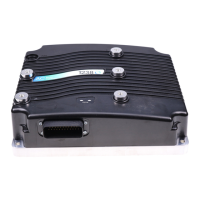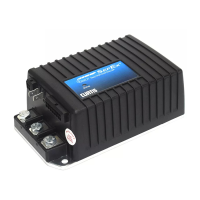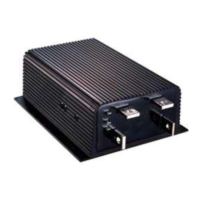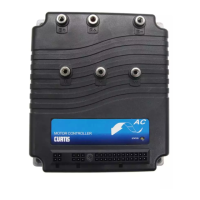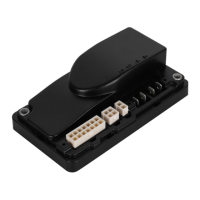4 — PROGRAMMABLE PARAMETERS
Curtis AC F4-A Motor Controller – August 2020 Return to TOC
pg. 58
APPLICATION SETUP/CAN INTERFACE — PDO SETUPS MENU
PARAMETER ALLOWABLE RANGE DEFAULT DESCRIPTION
RPDO1 Note: PDO transmissions are from the perspective of the ancillary controller
RPDOs are messages received by the ancillary (i.e., send from the manager)
Timeout
can_rpdo_1_event_timer
0x1400 0x05
0 – 65535
0 – 65535
40 ms Sets the PDO timeout period for the CANopen Ancillary system.
After the ancillary controller has sent a TPDO (PDO-TX), it will
declare a PDO Timeout Fault if the manager controller has not
sent a reply RPDO (PDO-RX) message within the time set by this
parameter. Any RPDO1-4 will reset the timer.
Setting this parameter to zero (Timeout = 0) disables the PDO
timeout fault check.
See Appendix A for PDO mapping/setup.
Application Note: Based upon the F-series cdev revision, this
timer may begin as soon as the controller goes operational (NMT
= 5), and not upon the first RPDO message received. Check this
aspect using a CANbus trace if unexpected PDO Timeout errors
occur.
COB ID
can_rpdo_1_cob_id
0x1400 0x01
0 – 0xFFFFFFFF
0 – 42949672295
80000226h The application’s 11-bit COB-ID (Communication Object ID).
Note: Use VCL for 29-bit COB ID.
See Appendix A.
Length
can_rpdo_1_length
0x1600 0x00
0 – 8
0 – 8
0 Number of CAN objects in map (not the number of bits or bytes).
See Appendix A.
1
can_rpdo_1_map_1
0x1600 0x01
0h – FFFFFFFFh
0 – 4294967295
0x00050008
327688
Map 1
st
object variable and bit length (8,16, 24, or 32).
See Appendix A.
The default value, 0x00050008 is a dummy 8-bit PDO variable (as
per CANopen).
2
can_rpdo_1_map_2
0x1600 0x02
0h – FFFFFFFFh
0 – 4294967295
0x00050008
327688
Map 2
nd
object variable and bit length (8, 16, 24, or 32).
See Appendix A.
3
can_rpdo_1_map_3
0x1600 0x03
0h – FFFFFFFFh
0 – 4294967295
0x00050008
327688
Map 3
rd
object variable and bit length (8, 16, 24, or 32).
See Appendix A.
4
can_rpdo_1_map_4
0x1600 0x04
0h – FFFFFFFFh
0 – 4294967295
0x00050008
327688
Map 4
th
object variable and bit length (8, 16, 24, or 32).
See Appendix A.
5
can_rpdo_1_map_5
0x1600 0x05
0h – FFFFFFFFh
0 – 4294967295
0x00050008
327688
Map 5
th
object variable and bit length (8, 16, 24, or 32).
See Appendix A.
6
can_rpdo_1_map_6
0x1600 0x06
0h – FFFFFFFFh
0 – 4294967295
0x00050008
327688
Map 6
th
object variable and bit length (8, 16, 24, or 32).
See Appendix A.
7
can_rpdo_1_map_7
0x1600 0x07
0h – FFFFFFFFh
0 – 4294967295
0x00050008
327688
Map 7
th
object variable and bit length (8, 16, 24, or 32).
See Appendix A.
8
can_rpdo_1_map_8
0x1600 0x08
0h – FFFFFFFFh
0 – 4294967295
0x00050008
327688
Map 8
th
object variable and bit length (8, 16, 24, or 32).
See Appendix A.
Quick Link:
Appendix A p.184
